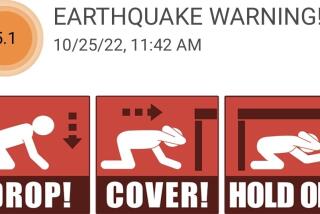Boosting our odds: App links CPR trainees to cardiac arrest victims

- Share via
Later this month I’ll be marking the two-year anniversary of my death.
That’s not a line you see too often, is it?
My heart gave out after knee surgery, because of an arrhythmia. Even for those who suffer cardiac arrest in a hospital, the survival rate is low. But I was lucky. A nurse quickly used CPR and brought me back from the dead in less than a minute.
Last week while driving to work I heard my cardiologist, Dr. Leslie Saxon, on KNX-AM (1070) talking about a new app that could save the lives of those stricken by cardiac arrest. The Los Angeles County Fire Department is encouraging civilians to download the app and join a growing army of crowd-sourced good Samaritans — 13,000 so far — who can keep someone alive until emergency crews arrive.
Before I tell you how the app works and how simple it is to use, let me tell you why it’s so important.
Cardiac arrest is a leading cause of death, killing more than 1,000 people a day in the United States. The victims, who include children, often have no symptoms and consider themselves perfectly healthy. As opposed to a heart attack (a plumbing problem in which blood flow to the heart is blocked), cardiac arrest is the sudden loss of heart function caused by an electrical malfunction in which the heart’s pumping action is disrupted.
Without CPR — and I mean chest compressions, not mouth-to-mouth resuscitation — death can occur within minutes. That means a five-minute response to a 911 call might be too late.
“It’s going to take a community to impact the dismal survival rates for out-of-hospital cardiac arrest patients,” Saxon said.
The idea for the app was hatched several years ago by a Bay Area fire chief who thought there must be a way to put the 13 million people with CPR training to better use. So, what if the moment someone dialed 911 in a case of cardiac arrest, nearby civilians could be notified on their mobile phones and do CPR until paramedics arrive?
Richard Price, now retired from the San Ramon Valley Fire Department, helped establish a nonprofit that has now linked its PulsePoint app to emergency systems in about 200 California fire departments and several hundred more around the country. He said the Los Angeles Fire Department may be signing on soon.
“There have been some pretty significant stories of lives saved, directly attributable to the app,” Price said.
Most interventions, so far, have been by off-duty emergency responders who downloaded the app. But as Price points out, any civilian can learn CPR in a matter of minutes. The PulsePoint app itself has a “how-to” feature with a diagram on how to place the heels of the hands in the center of the chest and push down firmly and rapidly, about 100 times per minute.
If you have the app and you’re in the L.A. County Fire Department coverage area, you’ll get a beep on your iPhone or Android device if you’re within one-quarter mile of where the fallen person is. Although it might be best in some cases to simply do CPR until trained responders arrive, a related app will give you a map showing where the nearest portable Automated External Defibrillator, or AED, is located.
Even if you’re not comfortable using one, you might be able to alert someone who is. Not all cases of cardiac arrest call for an AED, but the machines are designed for quick diagnosis, with clear and simple instructions on safe use by lay persons.
Price said it will take some time for the location of all AEDs to be loaded into the app. And it’s going to take some time, as well, for AEDs to become more prevalent. Concerns about cost ($1,200 or more per unit) and legal liability have impeded wider use.
Bob Roy, a Riverside man whose 14-year-old son, Travis, went into cardiac arrest at his middle school in 2005 and later died, has been lobbying to require schools to have AEDs.
“You’re a hundred times more likely to need an AED than a fire extinguisher, and which of those two are required by law?” asked Roy, who has helped place dozens of the devices in schools through the nonprofit thetravisfund.org.
Former state Sen. Joe Simitian, now a Santa Clara County supervisor, said resistance to AEDs is based in part on fears of legal liability if the devices malfunction. But the technology has improved dramatically since regulations were written, he said, and it may be time to legislatively broaden legal protection for those willing to try to save someone’s life.
More people die each year from cardiac arrest than from lung, breast, prostate and colon cancer combined. And Dr. Frank Pratt, medical director for the L.A. County Fire Department, says it’s time for cardiac arrest to be addressed with the same urgency.
“If this number of people were dying from an infection or a defect in an automobile or a stove, there’d be a national uproar,” Pratt said. “The PulsePoint app gives us an opportunity to reinvigorate the dialogue on the whole public health problem of sudden cardiac arrest.”
To find a CPR class, check the American Heart Association website at https://www.heart.org.
To get the app, go to your app store and search for PulsePoint, which is free and downloads in seconds.
The greater the number of participants, the greater the chance that you or a loved one might be saved one day. I’m living proof that it’s possible to be brought back from the dead.
More to Read
Sign up for Essential California
The most important California stories and recommendations in your inbox every morning.
You may occasionally receive promotional content from the Los Angeles Times.














